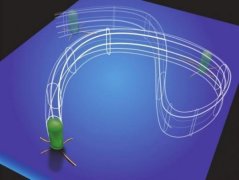
(Click Image for credit)
Microbiologists have already shown that bacteria can swim through liquid using their amazingly well-designed flagella. They have also found that bacteria can crawl along a surface. However, no one had ever caught them in the act of walking until a team of UCLA researchers started studying the dynamics of bacterial biofilms.
The researchers were studying Pseudomonas aeruginosa, a species of bacterium found in soil, water, and many human-made environments. It can cause lung, skin, eye, and gastrointestinal infections. Like many bacteria, members of the species can exist as either free-swimming individuals or surface-clinging colonies. The surface-clinging colonies form biofilms.
Interestingly enough, a free-swimming bacterium can be genetically identical to a member of a biofilm. However, because the two different lifestyles have different requirements, some genes are active in the free-swimming bacteria but not in the biofilm bacteria, and vice-versa. This switching on and off of genes produces bacteria that look and behave quite different, even though they have the same genome.
